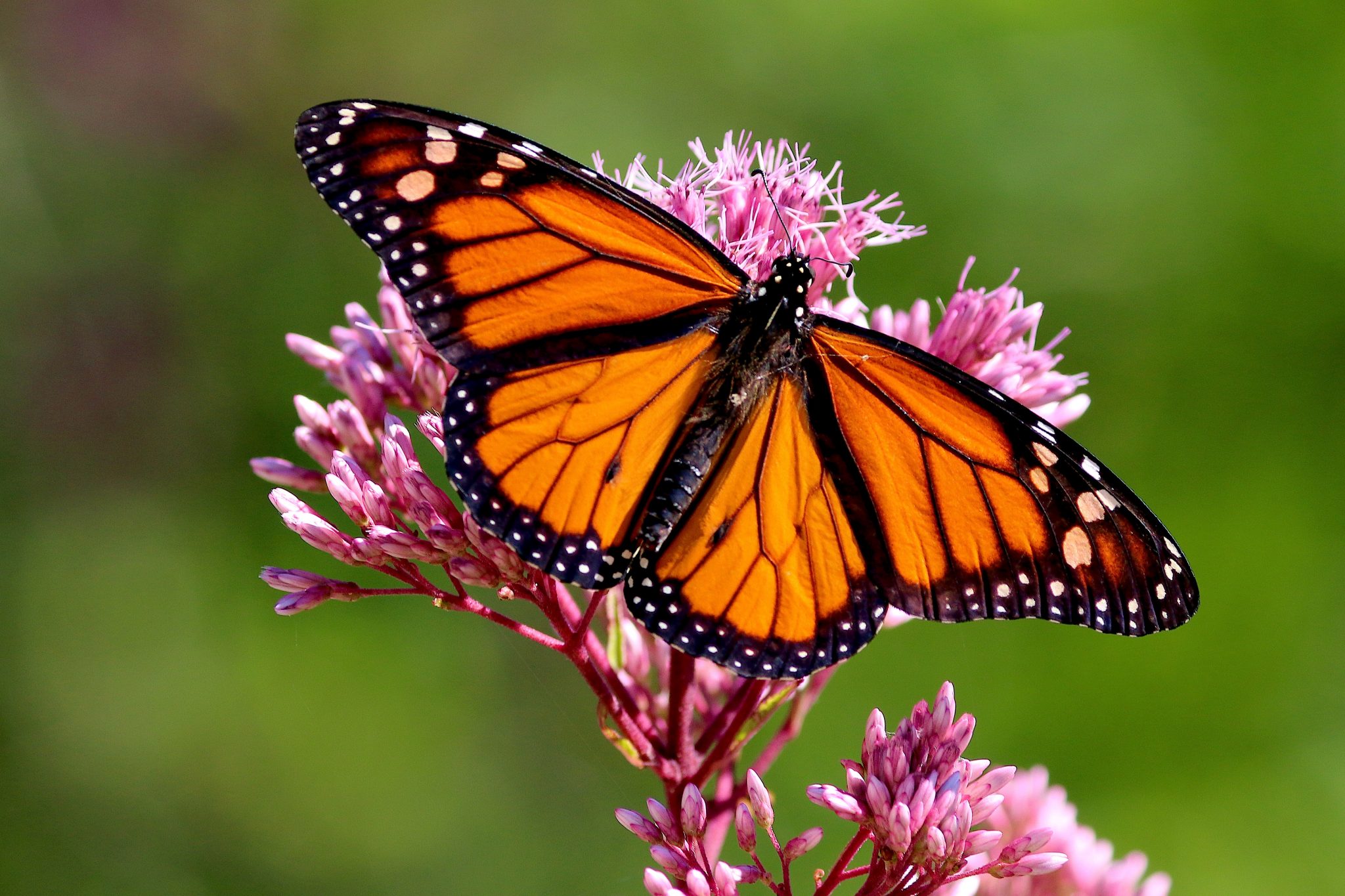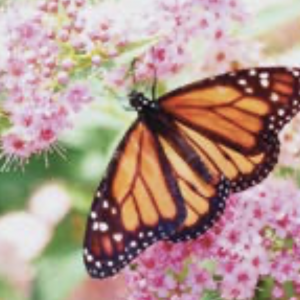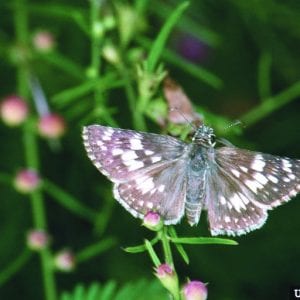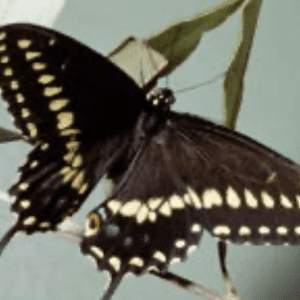Landscaping

For success in your butterfly garden, learn about butterflies—identify the adults and caterpillars, their food preferences, and where they live.
Butterflies have long fascinated humans. The ancient Egyptians, and later the Romans, believed they were symbols of the human soul. To make a wish come true, Native Americans suggested whispering it to a butterfly. They were messengers of the Great Spirit. Some native cultures of Mexico and the western United States believed butterflies were symbols of fertile ground. Today, tourists flock to the Monterey peninsula and central Mexico’s Transvolcanic Belt to see the monarch masses overwintering there.
To invite butterflies to your garden, you will first need to understand their life cycle. Butterflies have four stages of development: egg, caterpillar (or larva), chrysalis, and winged adult. Accommodate the needs of each stage for the greatest success.
Adult butterflies lay eggs on host plants so the larvae will have the necessary food to mature. At the end of this larval stage, they need a sturdy, protected place to attach and form the chrysalis. Adults survive eating sweet flower nectar.
Accommodating Each Stage
Host Plants
Most butterfly caterpillars have specific food preferences. Monarchs, for example, only lay eggs on milkweed. Black swallowtails lay eggs on any member of the carrot family, such as parsley, fennel, and dill, but no other plants. Once a caterpillar eats its first plant meal, it cannot survive on any other plant. See table 1 for host plants for different butterfly species.
Use a good reference book to identify which caterpillars become which butterflies. For example, by learning that parsley worms become black swallowtails, you will know not to kill those caterpillars. Plant extra host plants if you need any for your own use.
Table 1. Suggested Food Plants for Larval Stage Butterflies
| Plant Species | Adult Butterfly Species |
|---|---|
Aster (Aster species) | Pearly crescentspot |
Cherry laurel, black cherry, wild plum (Prunus species) | Tiger swallowtail |
| Clover (Trifolium species) and other legumes | Sulfur and gray hairstreak |
Dill, carrot, parsley, fennel, Queen Anne’s lace (Umbelliferae, parsley family) | Black swallowtail |
Dogwood (Cornus species) and viburnum | Spring azure |
| Elm (Ulmus species) and willow | Morning cloak, viceroy, and question mark |
| Hackberry (Celtis species) | Hackberry butterfly |
Milkweed (Asclepias species) | Monarch |
| Mustard family | Cabbage and checkered white |
Native grasses | Various skippers |
Oak (Quercus species) | Banded hairstreak |
Passion flower (Passiflora species) | Gulf fritillary and zebra longwing |
| Paw paw (Asimina species) | Zebra swallowtail |
Pearly everlasting (Antennaria, Anaphalis, andGnaphalium) | American painted lady |
Pipevine (Aristolochia species) | Pipevine swallowtail |
Plantain (Plantago species) and snapdragon | Buckeye |
Sassafrass (Sassafrass occidentalis) | Palamedes swallowtail |
Senna and coffeeweed (Cassia species) | Cloudless giant sulfur |
Spicebush (Lindera benzoin) | Spicebush swallowtail |
Tulip tree (Liriodendron tulipifera) | Red-spotted purple |
Pesticides
To avoid harming butterflies, which are insects, be careful when applying chemicals on or near plants. Spot treating pest insects with insecticidal soaps or oils leaves no chemical residue to harm caterpillars. You can handpick some pests, such as beetles. A regular, hard blast of water can remove other plant pests, such as aphids, that cause unplanned plant damage.
Another advantage of decreased garden chemical use is the presence of other garden helpers, which pesticides can kill. These beneficial critters, such as spiders, lacewings, ladybugs, and ground beetles, eat the plant pests. Other pollinators, such as honey bees, also benefit from reduced chemical use.
Location
Butterfly gardens should be in full sun. All insects are cold blooded. Their body temperature depends on the environmental temperature. Enhance the sun’s warming energy with stepping stones or a gravel path. Butterfly adults will bask in these areas to warm themselves from the radiant heat. Your garden will also benefit because most of the plants used by butterflies grow best in full sun.
Shelters
Include a few blooming shrubs in your butterfly garden or have evergreens nearby for shelter. Butterflies will hide in these areas on cloudy days or at night and find protection from the rain and wind. Your garden might even be located near the garage, gazebo, or garden shed. These permanent structures also give shelter and protection.
Chrysalids also benefit from these places. After a couple of weeks (varies by butterfly species), the caterpillars seek something sturdy for chrysalid attachment. If the host plant is sturdy, such as fennel, they’ll likely just use a rigid, inner stem. However, not all host plants satisfy this need. If you plan accordingly, woody stems, benches, arbors, or other solid supports will be ornamented with various chrysalids by July.
Puddles
Male butterfly adults need to puddle. They obtain water and minerals from the shallows of these wet places. To make a permanent puddle, bury a shallow pan of wet gravel or sand to its rim. Fill it with liquids, such as fruit drinks or plain tap water. You might even sprinkle it periodically with a liquid fertilizer when boosting the garden plants. Some butterflies, such as the viceroy, like to drink from rotten fruit. Locate the compost pile nearby, and allow rotting fruit to occasionally stay on top.
- Figure 1. Monarch adult.
- Figure 2. Checkered Skipper adult. Jerry A. Payne, USDA Agricultural Service, www.ipmimages.org
- Figure 3. Black Swallowtail adult. Gerald J. Lenhard, www.ipmimages.org
Flowers
Flowers provide the nectar food adult butterflies need. Butterfly season in Alabama is early spring to late fall. Choose a variety of plants, including annuals, perennials, and woody shrubs, to have flowers continuously through the seasons. This plant diversity also attracts a greater variety of butterfly visitors. Many of Alabama’s native butterflies often visit purple, red, orange, and yellow flowers.
How many insects have you noticed flying in a straight line? Remember, butterflies are insects. Their compound eyes have poor vision for distinguishing tiny details. Large sweeps of each flower are most attractive to these near-sighted creatures.
Also, consider their mouthparts. Butterflies suck liquid food with a strawlike mouth. Tubular-shaped flowers are ideally suited. Butterflies prefer clusters of tubular or flat-topped flowers, but remember to have variety. Different species have different preferences for flower size. Compound flowers, such as verbena, daisies, and butterfly bushes, offer numerous nectar containers for sipping in a single stop.
Nectar
Butterflies have a highly developed sense of smell in their antennae. They seek flowers with rich nectar. Surprisingly, some of our newer plant varieties have little sugary nectar because of the breeding and selection process for other plant traits. Choose open-pollinated, fragrant, flowering plants with a single rather than a double petal row. Fragrance is sometimes a nectar signal that you can easily detect.
Keys to choosing flowers in your butterfly garden are a long bloom time, a variety of plants, large areas of a single color, tubular-shaped and compound flowers, and rich nectar. See table 2 for recommended flowering plants.
Table 2. Nectar Sources for Adult Butterflies
| Plant | Flower Color | Bloom Period |
|---|---|---|
Shrubs | ||
Azalea | variable | spring |
Buddleia | variable | summer to fall |
Sumac | white | spring |
Vaccinium spp. | white, light pink | spring to early summer |
Viburnum | white | spring |
Abelia | white, lavender | summer |
Lantana | variable | summer (this plant may be invasive in south Alabama) |
Annuals | ||
Alyssum | violet, white | summer to fall |
Candytuft | white, pink | spring to summer |
Cosmos | white, pink, red, yellow | summer |
Gaillardia | yellow, orange | summer to fall |
Impatiens | variable | summer to fall |
Marigold | yellow, orange | summer to fall |
Scabiosa | blue, rose, white | summer to fall |
Verbena | variable | summer to fall (some annual, some perennial) |
Zinnia | variable | summer to fall |
Pansy, viola, pinnola | variable | fall to spring |
Pentas | pink, purple, white, red | summer |
Perennials | ||
Aster | white, lavender, yellow | summer to fall |
Bee balm | red, white, pink | summer |
Butterfly weed (milkweed) | orange, pink, red, yellow | summer |
Salvias | variable | summer to fall |
Catmint | lavender | summer |
Phlox | pink, lavender, white | spring, summer to fall |
Primrose | variable | spring |
Purple coneflower | purple, white | midsummer |
Sedum spectabile | pink | late summer |
Boneset | white, purple | late summer |
Black-eyed susan | yellow | summer |
Blazing star | purple | summer |
Dandelion | yellow | spring to fall |
Goldenrod | yellow | late summer |
Joe-Pye weed | lavender | late summer |
Yarrow | variable | spring to early summer |
References
Brock, Jim P. and Kenn Kaufman. 2003. Butterflies of North America. Kaufman Focus Guides.
Glassberg, Jeffrey. 1999. Butterflies Through Binoculars: The East.
Potter-Springer, Wendy. 1990. “Grow a Butterfly Garden.” Storey Country Wisdom Bulletin A-114.
Pyle, Robert Michael. 1981. National Audubon Society Field Guide to North American Butterflies.
Tekulsky, Mathew. 1986. The Butterfly Garden: Turning Your Garden, Window Box, or Backyard into a Beautiful Home for Butterflies.
Wagner, David L. 2005. Caterpillars of Eastern North America: A Guide to Identification and Natural History. Princeton Field Guides.
Wright, Amy Bartlett, and Roger Tory Peterson. 1998. Peterson First Guide to Caterpillars of North America.
Download a PDF of Butterfly Gardens, ANR-1290.





